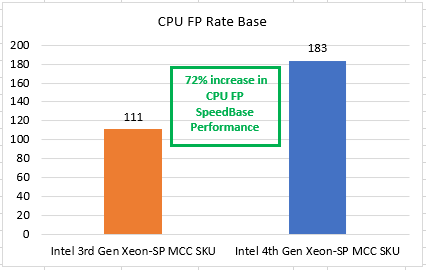

Next-Generation Dell PowerEdge XR Server CPU Improvements
Download PDFFri, 03 Mar 2023 19:57:24 -0000
|Read Time: 0 minutes
Summary
Dell Technologies has recently introduced the next generation of Dell PowerEdge XR servers. Powered by 4th Gen Intel® Xeon® Scalable processors with the MCC SKU stack, these servers deliver advanced performance in an energy-efficient design. Dell continues to provide scalability and flexibility with its latest portfolio of short-depth XR servers. These servers integrate technologies such as 4th Gen Intel CPUs, PCIe Gen5, DDR5, NVMe drives, and GPU slots, and they are compliance-tested for NEBS and MIL-STD.
This tech note discusses our CPU performance benchmark testing of the next-generation PowerEdge XR server portfolio and the test results that show improvements over previous PowerEdge XR servers powered by 3rd Gen Intel Xeon Scalable processors and Xeon D processors.
Benchmarks
4th Gen Intel Xeon Scalable processors with the MCC SKU stack were tested using the STREAM and HPL benchmarks and compared with the CPU of the previous generation of XR servers.
STREAM
The STREAM benchmark is a simple, synthetic benchmark designed to measure sustainable memory bandwidth (in MB/s) and a corresponding computation rate for four simple vector kernels: Copy, Scale, Add, and Triad. The STREAM benchmark is designed to work with datasets much larger than the available cache on any system so that the results are (presumably) more indicative of the performance of very large, vector-style applications. Ultimately, we get a reference for compute performance.
HPL
HPL is a high-performance LINPACK benchmark implementation. The code solves a uniformly random system of linear equations and reports time and floating-point operations per second using a standard formula for operation count. It also helps to provide a reference for a system’s compute speed performance.
Performance results
Benchmark testing showed significant performance increases with the 4th Gen Intel Xeon Scalable MCC SKU stack when it was compared with both the Intel Xeon D SKU and the 3rd Gen Intel Xeon Scalable MCC SKU.
Comparison of 4th Gen Intel Xeon Scalable MCC SKU with Intel Xeon D SKU
In our tests, the single-socket PowerEdge XR servers with the 4th Gen Intel Xeon Scalable CPU (32 core) MCC SKU stack delivered a 253 percent increase in HPL performance and a 182 percent increase in STREAM performance. Thus, these servers are faster at the network edge or enterprise edge than the previous-generation PowerEdge XR servers powered by the Intel Xeon D (16 core) SKU.
Figure 1 and Figure 2 show the results of the benchmark tests that compared the performance of the 4th Gen Intel Xeon Scalable processor MCC SKU stack with the Intel Xeon D SKU.

Figure 1. HPL performance comparison: Intel Xeon D SKU and 4th Gen Intel Xeon Scalable MCC SKU

Figure 2. STREAM performance comparison: Intel Xeon D SKU and 4th Gen Intel Xeon Scalable MCC SKU
Comparison of 4th Gen and 3rd Gen Intel Xeon Scalable MCC SKU
In our tests, the single-socket PowerEdge XR servers with the 4th Gen Intel Scalable CPU (32 core) MCC stack delivered a 52 percent increase in STREAM performance and a 72 percent increase in CPU FP rate base performance (floating point performance for the CPU). Thus, these servers are faster for compute at the network edge or enterprise edge than the previous generation of PowerEdge XR servers powered by the 3rd Gen Intel Xeon Scalable MCC SKU.
Figure 3 and Figure 4 show the results of the benchmark tests that compared the performance of the 4th Gen and 3rd Gen Intel Xeon Scalable processor MCC SKU stacks.

Figure 3. STREAM performance for 4th and 3rd Gen Intel Xeon Scalable processors

Figure 4. CPU FP rate base performance for 4th and 3rd Gen Intel Xeon Scalable processors
Conclusion
The Dell PowerEdge XR portfolio continues to provide CPU-based improvements and a streamlined approach for various edge and telecom deployment options. The XR portfolio provides a solution to the challenge of needing a small form factor at the edge with industry-standard rugged certifications (NEBS). It provides a compact solution for scalability along with flexibility for operating in temperatures ranging from –5°C to +55°C.
References


